ETA: I liked this one so much I kickstarted the second edition of the deck. That was a mistake. The artist promised lots of "awesome" rewards for reaching stretch goals. There were no rewards, only overpriced add-ons. Which, fine, backers aren't obligated to buy anything extra, and the campaign ran smoothly, with great communication...until the creator received backers' payments.
Then, silence. And delays. And delays. And more delays. Not a peep. Deadlines came and went. And when backers' items finally shipped, well after they were supposed to, they were defective. A free digital download of the physical item backers paid for does not make up for any of this. I do not recommend this this creator anymore.
It's been awhile, so how about another Tarot Tuesday? This week's selection is the Reverie Tarot, a deck I kickstarted last fall.
I'm not a fan of Smith Waite clones, but I very much like Smith Waite-inspired decks that put a new spin on the original, which the Reverie Tarot definitely does. Here, the spin is minimalism. The artist has illustrated the majors and minors with tiny figures in jewel-like, off-primary colors. Her illustrations are drawn within the outlines of the card's number for the majors, and within the outlines of the suit's symbol for the minors. As a concept, it has the potential to fall pretty flat, but it absolutely works.
(NB: I'm not sure how well any of these pictures turned out, as I use pretty odd screen resolutions on all my devices, but trust me, the actual cards are gorgeous.)
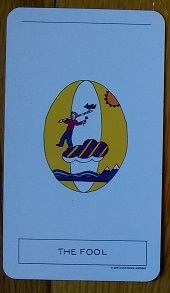
Here's the Fool, about to stride off not a mountain, but a cloud. Along with the waves below, it's one of the recurring motifs in the deck that gives the cards a sense of cohesion.
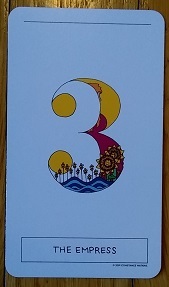
Here's the Empress. I love how the shape of the '3' forms the swell of her pregnant belly. The deck is full of visual puns like this, and it's delightful. Sometimes these puns use the entire figure from the original Smith Waite, as they do here.
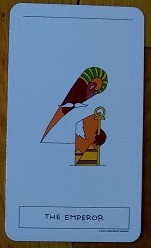
And sometimes, they incorporate just an element or two from Smith's illustrations, such as in this card, where the artist takes the Waite Smith emperor's scepter, the rams' heads from his throne, and the mountains from the card's background, and makes them the entirety of the card. Again, I love how the ram's horn traces the outline of the '4.'

The borrowing can be pretty subtle, as in the Star, which incorporates only the seven bright stars and the bird in the tree from Smith's illustration. But the effect: basically a big, starry night sky, is lovely. The artist also re-conceptualizes some of the majors and I really like her takes when she does, as here in the Hanged Man, whose namesake is suspended from the card's numeral. The fiery phoenix rising from the Reverie Tarot's Death card is a complete departure from the Smith Waite card, and I love it. It's one of my favorite cards in the deck.
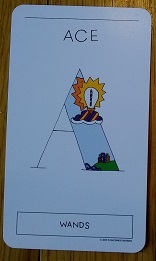
The artist pays just as much attention to the minors. The Ace of Wands, in which the wand is the filament in a light bulb, is fun and playful and precisely captures the meaning of the card.
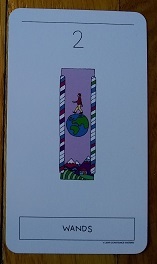
The Two of Wands is another good example of the artist working well within the boundaries she's set--illustrating within the suit symbol--to reimagine Pixie's illustration from this card.
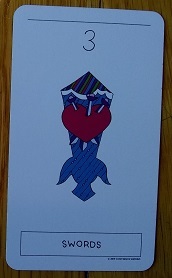
The Three of Swords, meanwhile, corresponds directly to Pixie's illustration, which itself comes from the 15th-century Sola Busca deck.
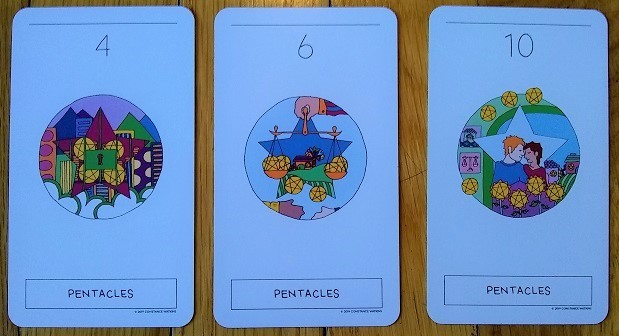
Like I said, the pip illustrations are pretty intricate, for all that this is a minimalist deck. The Four, Six, and Ten of Pentacles are nice demonstrations of how the artist pulls and emphasizes elements of Pixie's original illustrations in her own interpretations of the cards.
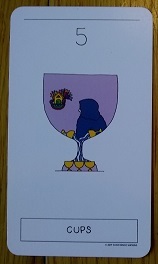
Again, there are a lot of fun visual puns going on the minors, like in the Five of Cups, where liquid from the Waite Smith's two overturned cups deck forms the stem of the suit symbol here, and then fills the other three cups from the original card's illustration.
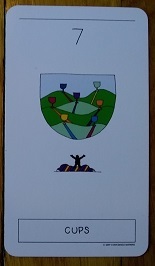
Look closely, or you'll miss how the arms of the dreaming figure in the Waite Smith Seven of Cups form the stem of the cup here.
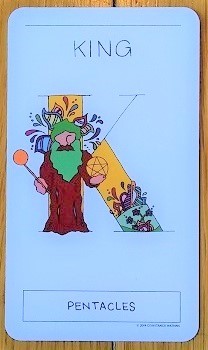
The court cards are delightful too. I'm especially fond of the King of Pentacles, which really suggests the earthiness and fecundity of the original.
The backs of the cards are nothing special, just a blue and white plaid, but it works with the deck's minimalist aesthetic. The card stock is pretty thin and floppy and allows for actual shuffling, which I love.
I fell in love with this deck as soon as I opened it, and it's one of the decks I read from most.
これで以上です。
Then, silence. And delays. And delays. And more delays. Not a peep. Deadlines came and went. And when backers' items finally shipped, well after they were supposed to, they were defective. A free digital download of the physical item backers paid for does not make up for any of this. I do not recommend this this creator anymore.
It's been awhile, so how about another Tarot Tuesday? This week's selection is the Reverie Tarot, a deck I kickstarted last fall.
I'm not a fan of Smith Waite clones, but I very much like Smith Waite-inspired decks that put a new spin on the original, which the Reverie Tarot definitely does. Here, the spin is minimalism. The artist has illustrated the majors and minors with tiny figures in jewel-like, off-primary colors. Her illustrations are drawn within the outlines of the card's number for the majors, and within the outlines of the suit's symbol for the minors. As a concept, it has the potential to fall pretty flat, but it absolutely works.
(NB: I'm not sure how well any of these pictures turned out, as I use pretty odd screen resolutions on all my devices, but trust me, the actual cards are gorgeous.)

Here's the Fool, about to stride off not a mountain, but a cloud. Along with the waves below, it's one of the recurring motifs in the deck that gives the cards a sense of cohesion.

Here's the Empress. I love how the shape of the '3' forms the swell of her pregnant belly. The deck is full of visual puns like this, and it's delightful. Sometimes these puns use the entire figure from the original Smith Waite, as they do here.

And sometimes, they incorporate just an element or two from Smith's illustrations, such as in this card, where the artist takes the Waite Smith emperor's scepter, the rams' heads from his throne, and the mountains from the card's background, and makes them the entirety of the card. Again, I love how the ram's horn traces the outline of the '4.'

The borrowing can be pretty subtle, as in the Star, which incorporates only the seven bright stars and the bird in the tree from Smith's illustration. But the effect: basically a big, starry night sky, is lovely. The artist also re-conceptualizes some of the majors and I really like her takes when she does, as here in the Hanged Man, whose namesake is suspended from the card's numeral. The fiery phoenix rising from the Reverie Tarot's Death card is a complete departure from the Smith Waite card, and I love it. It's one of my favorite cards in the deck.

The artist pays just as much attention to the minors. The Ace of Wands, in which the wand is the filament in a light bulb, is fun and playful and precisely captures the meaning of the card.

The Two of Wands is another good example of the artist working well within the boundaries she's set--illustrating within the suit symbol--to reimagine Pixie's illustration from this card.

The Three of Swords, meanwhile, corresponds directly to Pixie's illustration, which itself comes from the 15th-century Sola Busca deck.

Like I said, the pip illustrations are pretty intricate, for all that this is a minimalist deck. The Four, Six, and Ten of Pentacles are nice demonstrations of how the artist pulls and emphasizes elements of Pixie's original illustrations in her own interpretations of the cards.

Again, there are a lot of fun visual puns going on the minors, like in the Five of Cups, where liquid from the Waite Smith's two overturned cups deck forms the stem of the suit symbol here, and then fills the other three cups from the original card's illustration.

Look closely, or you'll miss how the arms of the dreaming figure in the Waite Smith Seven of Cups form the stem of the cup here.

The court cards are delightful too. I'm especially fond of the King of Pentacles, which really suggests the earthiness and fecundity of the original.
The backs of the cards are nothing special, just a blue and white plaid, but it works with the deck's minimalist aesthetic. The card stock is pretty thin and floppy and allows for actual shuffling, which I love.
I fell in love with this deck as soon as I opened it, and it's one of the decks I read from most.
これで以上です。